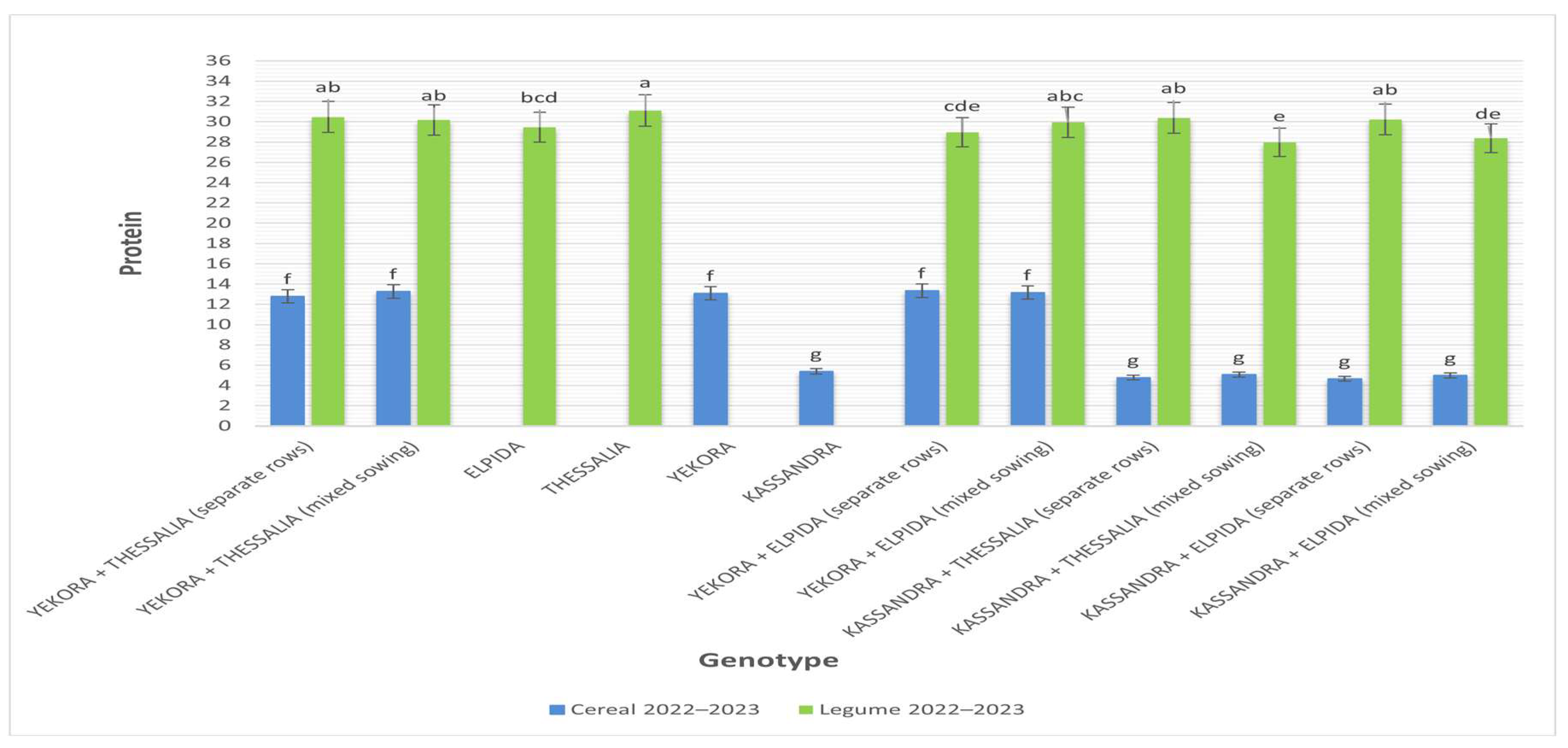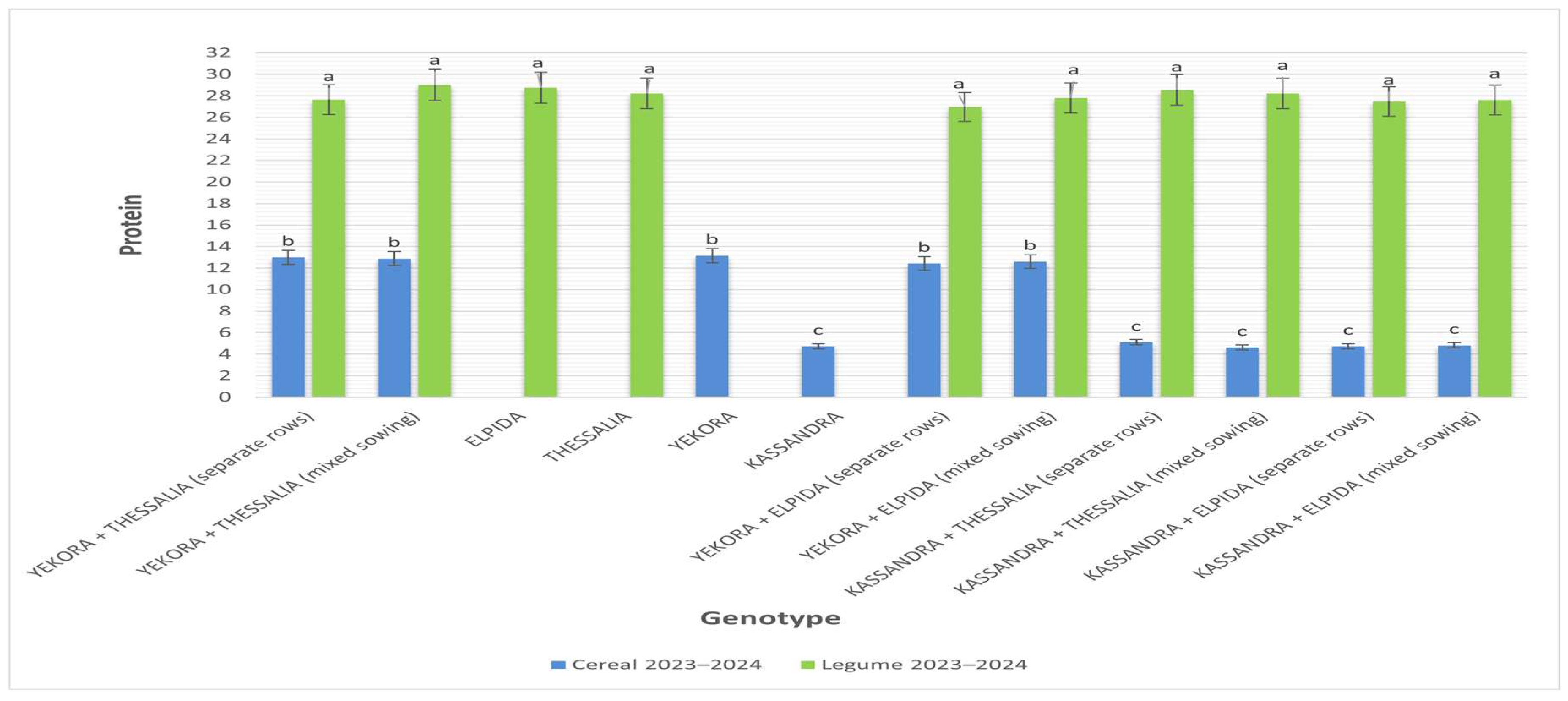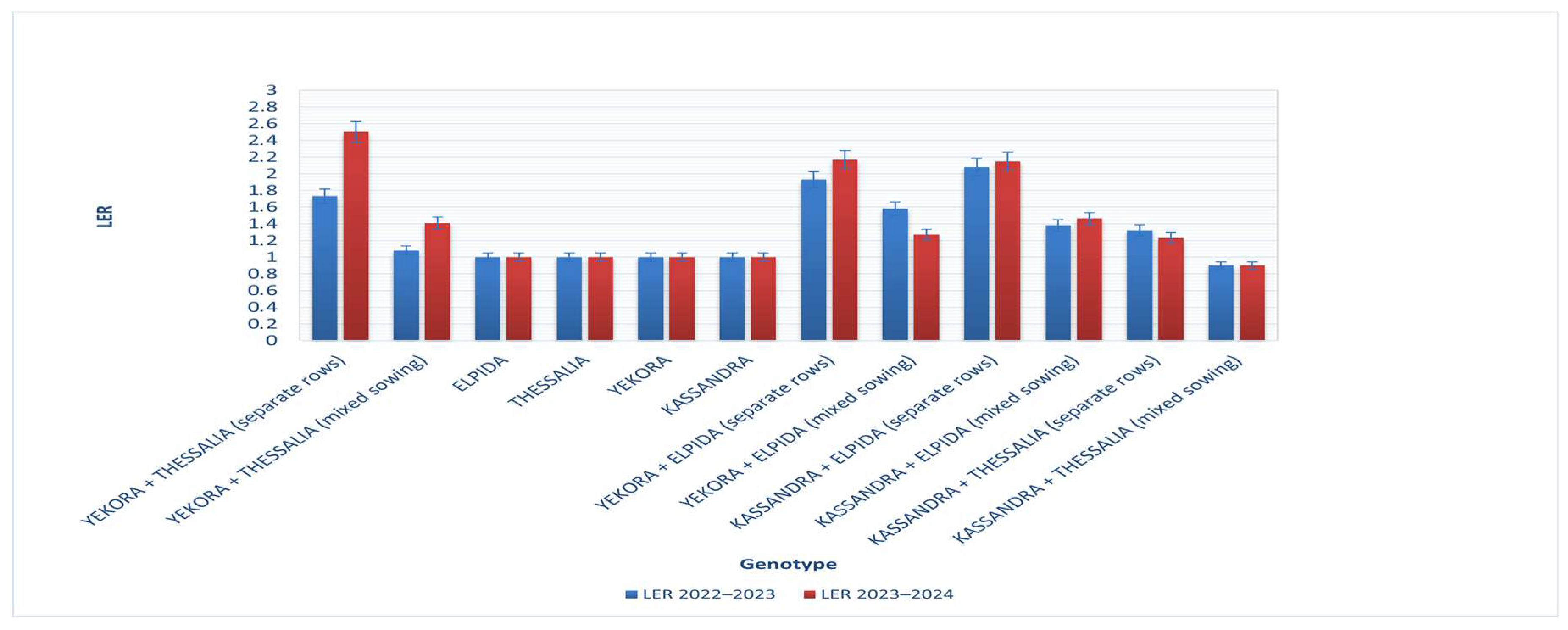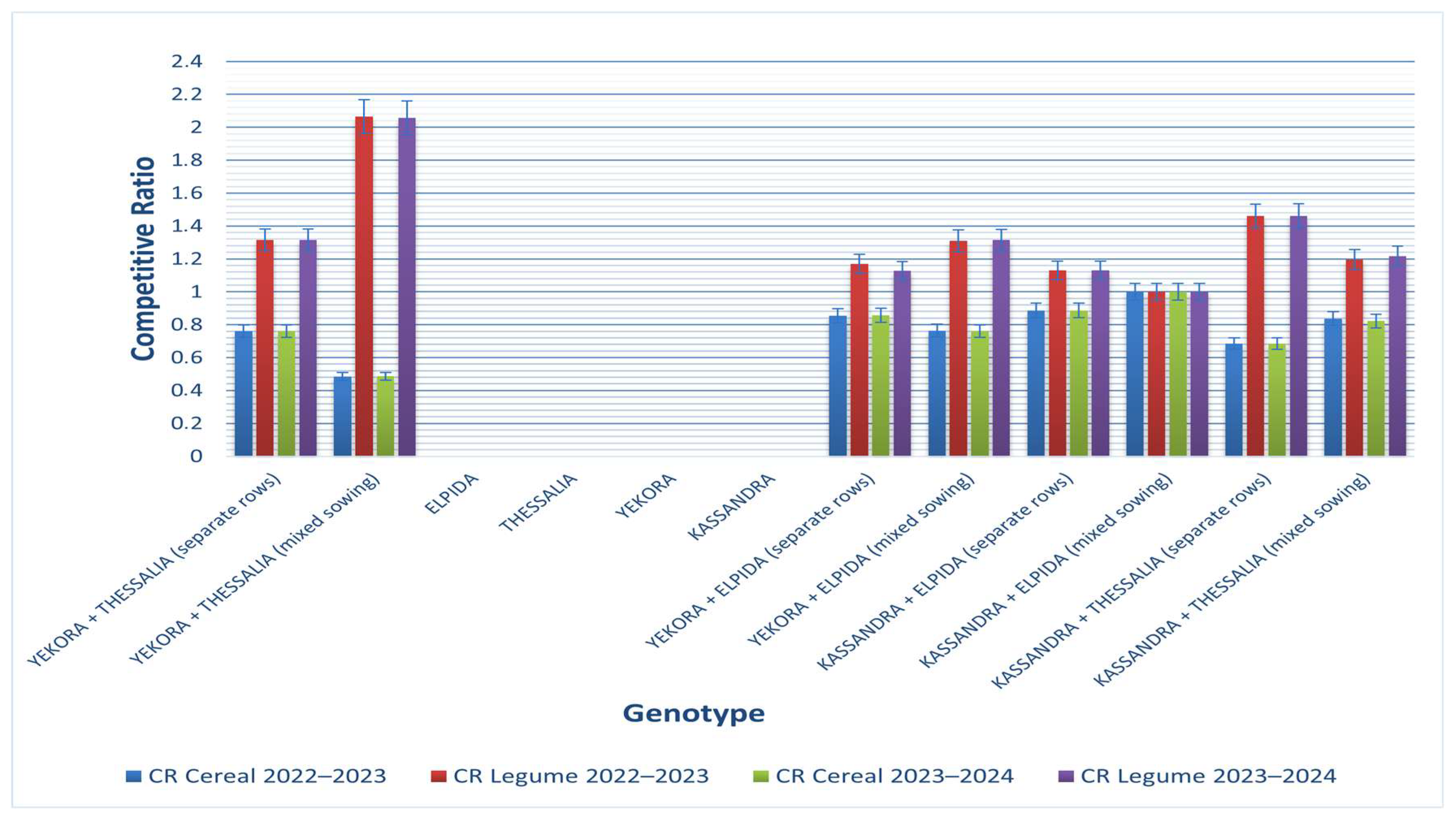Intercropping of Cereals with Lentil: A New Strategy for Producing High-Quality Animal and Human Food
Abstract
1. Introduction
2. Materials and Methods
- YCL: Yield of the cereal in the intercrop.
- YLC: Yield of the legume in the intercrop.
- YC mono: Yield of the cereal in monoculture.
- YL mono: Yield of the legume in monoculture.
- ZCL, ZLC: Sowing proportions of the cereal and the legume, respectively, in the intercrop (as a fraction of their full monoculture sowing rate).
Statistical Analysis
3. Results
3.1. Grain Yield
3.2. Seed Quality
3.3. Competition Indices
4. Discussion
4.1. Yield Variation and Spatial Arrangement
4.2. Physiological Mechanisms and Competitive Dynamics
4.3. Protein Content and Nutrient Allocation
4.4. Broader Agronomic and Ecological Considerations
4.5. Comparison with Other Intercropping Systems
5. Conclusions
- Quantifying the environmental benefits of intercropping (e.g., reduced fertilizer use, soil health improvement).
- Incorporating economic evaluation (e.g., cost–benefit ratios, net returns).
- Exploring below-ground interactions (e.g., mycorrhizal symbiosis, nitrogen transfer mechanisms).
- Evaluating multi-season and multi-location performance to support wider adoption.
Author Contributions
Funding
Data Availability Statement
Acknowledgments
Conflicts of Interest
Abbreviations
| CPY | Crude protein yield |
| LER | Land equivalent ratio |
| CR | Competitive ratio |
| A | Aggressivity |
References
- Dordas, C.A.; Lithourgidis, A.S.; Vlachostergios, D.N. Effects of intercropping systems on wheat and lupin yield and weed population under organic farming conditions. Exp. Agric. 2008, 44, 369–383. [Google Scholar]
- Koskey, G.; Leoni, F.; Carlesi, S.; Avio, L.; Bàrberi, P. Exploiting plant functional diversity in durum wheat–lentil relay intercropping to stabilize crop yields under contrasting climatic conditions. Agronomy 2022, 12, 210. [Google Scholar] [CrossRef]
- Banik, P.; Midya, A.; Sarkar, B.K.; Ghose, S.S. Evaluation of wheat (Triticum aestivum) and chickpea (Cicer arietinum) intercropping systems in an additive series under rainfed conditions. Eur. J. Agron. 2006, 24, 296–303. [Google Scholar] [CrossRef]
- Wang, L.; Gruber, S.; Claupein, W. Optimizing lentil-based mixed cropping with different companion crops and plant densities in terms of crop yield and weed control. Org. Agric. 2012, 2, 79–87. [Google Scholar] [CrossRef]
- Koçer, A.; Albayrak, S. Determination of forage yield and quality of pea (Pisum sativum L.) mixtures with oat and barley. Turk. J. Field Crops 2012, 17, 96–99. [Google Scholar]
- Bedoussac, L.; Journet, E.-P.; Hauggaard-Nielsen, H.; Naudin, C.; Corre-Hellou, G.; Jensen, E.S.; Justes, E. Grain legume–cereal intercropping systems. In Achieving Sustainable Cultivation of Grain Legumes; Sivasankar, S., Bergvinson, D., Agrawa, S.K., Tamò, M., Eds.; Burleigh Dodds Science Publishing Limited: Sawston, UK, 2018; Volume 1, pp. 243–255. [Google Scholar] [CrossRef]
- Jensen, E.S.; Peoples, M.B.; Hauggaard-Nielsen, H. Faba bean in cropping systems. Field Crops Res. 2010, 115, 203–216. [Google Scholar] [CrossRef]
- Tang, X.; Zhang, C.; Yu, Y.; Shen, J.; van der Werf, W.; Zhang, F. Intercropping legumes and cereals increases phosphorus use efficiency; a meta-analysis. Plant Soil 2021, 460, 89–104. [Google Scholar] [CrossRef]
- Odongo, J.C.W.; Ouma, J.K.; Woomer, A. Intercropping of maize with legumes in western Kenya. East Afr. Agric. For. J. 1986, 51, 1–9. [Google Scholar]
- Lithourgidis, A.S.; Dordas, C.A.; Lazaridou, T.B.; Papadopoulos, I.I. Silage yield and protein content of common bean intercropped with corn in two row replacements. In Proceedings of the 10th European Society of Agronomy (ESA) Congress, Bologna, Italy, 15–19 September 2008; pp. 217–218. [Google Scholar]
- Lithourgidis, A.S.; Dordas, C.A. Forage yield, growth rate, and nitrogen uptake of faba bean intercrops with wheat, barley, and rye in three seeding ratios. Crop Sci. 2010, 50, 2148–2158. [Google Scholar] [CrossRef]
- Dordas, C.A.; Vlachostergios, D.N.; Lithourgidis, A.S. Growth dynamics and agronomic-economic benefits of pea–oat and pea–barley intercrops. Crop Pasture Sci. 2012, 63, 45–52. [Google Scholar] [CrossRef]
- Menbere, S.; Dejene, M.; Abreha, S. Dry matter yield and agronomic performance of herbaceous legumes intercropped with Napier grass (Pennisetum purpureum) in the semi-arid areas of eastern Amhara region. Int. J. Recent Res. Life Sci. 2015, 2, 7–14. [Google Scholar]
- Viguier, L.; Bedoussac, L.; Journet, E.-P.; Justes, E. Yield gap analysis extended to marketable grain reveals the profitability of organic lentil-spring wheat intercrops. Agron. Sustain. Dev. 2018, 38, 39. [Google Scholar] [CrossRef]
- Lithourgidis, A.S.; Dordas, C.A.; Damalas, C.A.; Vlachostergios, D.N. Annual intercrops: An alternative pathway for sustainable agriculture. Aust. J. Crop Sci. 2011, 5, 396–410. [Google Scholar]
- Dhima, K.V.; Lithourgidis, A.S.; Vasilakoglou, I.B.; Dordas, C.A. Competition indices of common vetch and cereal intercrops in two seeding ratios. Field Crops Res. 2007, 100, 249–256. [Google Scholar] [CrossRef]
- Willey, R.W. Intercropping—Its importance and research needs. Part 1. Competition and yield advantages. Field Crop Abstr. 1979, 32, 1–10. [Google Scholar]
- Wetterer, J.K. Foraging and nesting ecology of a Costa Rican leaf-cutting ant, Acromyrmex volcanus. Psyche 1993, 100, 65–76. [Google Scholar]
- Tosti, G.; Falcinelli, B.; Guiducci, M. Lentil–cereal intercropping in a Mediterranean area: Yield, pests and weeds. Agron. J. 2023, 115, 2570–2578. [Google Scholar] [CrossRef]
- Raza, M.A.; Ud Din, A.M.; Zhiqi, W.; Gul, H.; Rehman, S.U.; Bukhari, B.; Haider, I.; Ur Rahman, M.H.; Liang, X.; Luo, S.; et al. Spatial diferences infuence nitrogen uptake, grain yield, and land-use advantage of wheat/soybean relay intercropping systems. Sci. Rep. 2023, 13, 16916. [Google Scholar] [CrossRef]
- Michalitsis, A.; Papakaloudis, P.; Pankou, C.; Lithourgidis, A.; Menexes, G.; Dordas, C. Effect of cultivar on faba bean–wheat intercrop productivity under a Mediterranean environment. Agronomy 2024, 14, 70. [Google Scholar] [CrossRef]
- Hoang, T.N.; Konvalina, P.; Kopecký, M.; Ghorbani, M.; Nguyen, T.G.; Bernas, J.; Murindangabo, Y.T.; Capouchova, I.; Shim, S.; Cepkova, H.P. Assessing the quality and grain yield of winter wheat in the organic farming management under wheat-legume intercropping practice. Heliyon 2024, 10, e31234. [Google Scholar] [CrossRef]
- Demie, D.T.; Doring, T.F.; Finckh, M.R.; van der Werf, W.; Enjalbert, J.; Seidel, S.J. Mixture × Genotype Effects in Cereal/Legume Intercropping. Front. Plant Sci., Sec. Plant Breed. 2022, 13, 846720. [Google Scholar] [CrossRef]
- Ross, S.M.; King, J.R.; O’Donovan, J.T.; Spaner, D. Intercropping berseem clover with barley and oat cultivars for forage. Agron. J. 2005, 97, 1200–1206. [Google Scholar] [CrossRef]
- Bijarnia, A.; Tetarwal, J.P.; Yadav, R.K.; Bijrania, A.L.; Singh, D.; Saini, Y. Effect of fertility levels and stress mitigating chemicals on nutrient content, uptake, intercropping advantage and competition effect in cowpea-baby corn intercropping. Heliyon 2024, 10, e38194. [Google Scholar] [CrossRef] [PubMed]
- Lorenzetti, E.; Leoni, F.; Koskey, G.; Bàrberi, P. Increasing diversity gradient in lentil mixtures for intercropping with wheat reveals an increase in lentil biomass with minimal impact on mycorrhizal activity. Agric. Ecosyst. Environ. 2024, 357, 108696. [Google Scholar] [CrossRef]
- Duchene, O.; Vian, J.-F.; Celette, F. Intercropping with legume for agroecological cropping systems: Complementarity and facilitation processes and the importance of soil microorganisms—A review. Agric. Ecosyst. Environ. 2017, 240, 148–161. [Google Scholar] [CrossRef]
- Zingale, S.; Spina, A.; Ingrao, C.; Fallico, B.; Timpanaro, G.; Anastasi, U.; Guarnaccia, P. Factors Affecting the Nutritional, Health, and Technological Quality of Durum Wheat for Pasta-Making: A Systematic Literature Review. Plants 2023, 12, 530. [Google Scholar] [CrossRef]
- Chimonyo, V.G.P.; Govender, L.; Nyathi, M.; Scheelbeek, P.F.D.; Choruma, D.J.; Mustafa, M.; Massawe, F.; Slotow, R.; Modi, A.T.; Mabhaudhi, T. Can cereal-legume intercrop systems contribute to household nutrition in semi-arid environments: A systematic review and meta-analysis. Front. Nutr. 2023, 10, 1060246. [Google Scholar] [CrossRef]
- Addo-Quaye, A.A.; Darkwa, A.A.; Ocloo, G.K. Yield and productivity of component crops in a maize-soybean intercropping system as affected by time of planting and spatial arrangement. J. Agric. Biol. Sci. 2011, 6, 50–57. [Google Scholar]
- Galanopoulou, K.; Lithourgidis, A.; Dordas, C. Intercropping of Faba Bean with Barley at Various Spatial Arrangements Affects Dry Matter and N Yield, Nitrogen Nutrition Index, and Interspecific Competition. Not. Bot. Horti. Agrobo. 2019, 47, 1116–1127. [Google Scholar]
- Gennatos, K.; Lazaridou, T.B. Silage Yield and protein content of forage legumes intercropping with cereals in two spatial arrangements. Agrofor 2021, 6. [Google Scholar]
- Tosti, G.; Guiducci, M. Durum wheat–faba bean temporary intercropping: Effects on nitrogen supply and wheat quality. Eur. J. Agron. 2010, 33, 157–165. [Google Scholar] [CrossRef]







Disclaimer/Publisher’s Note: The statements, opinions and data contained in all publications are solely those of the individual author(s) and contributor(s) and not of MDPI and/or the editor(s). MDPI and/or the editor(s) disclaim responsibility for any injury to people or property resulting from any ideas, methods, instructions or products referred to in the content. |
© 2025 by the authors. Licensee MDPI, Basel, Switzerland. This article is an open access article distributed under the terms and conditions of the Creative Commons Attribution (CC BY) license (https://creativecommons.org/licenses/by/4.0/).
Share and Cite
Gkalitsas, T.; Papathanasiou, F.; Lazaridou, T. Intercropping of Cereals with Lentil: A New Strategy for Producing High-Quality Animal and Human Food. Agronomy 2025, 15, 1658. https://doi.org/10.3390/agronomy15071658
Gkalitsas T, Papathanasiou F, Lazaridou T. Intercropping of Cereals with Lentil: A New Strategy for Producing High-Quality Animal and Human Food. Agronomy. 2025; 15(7):1658. https://doi.org/10.3390/agronomy15071658
Chicago/Turabian StyleGkalitsas, Theodoros, Fokion Papathanasiou, and Theano Lazaridou. 2025. "Intercropping of Cereals with Lentil: A New Strategy for Producing High-Quality Animal and Human Food" Agronomy 15, no. 7: 1658. https://doi.org/10.3390/agronomy15071658
APA StyleGkalitsas, T., Papathanasiou, F., & Lazaridou, T. (2025). Intercropping of Cereals with Lentil: A New Strategy for Producing High-Quality Animal and Human Food. Agronomy, 15(7), 1658. https://doi.org/10.3390/agronomy15071658








